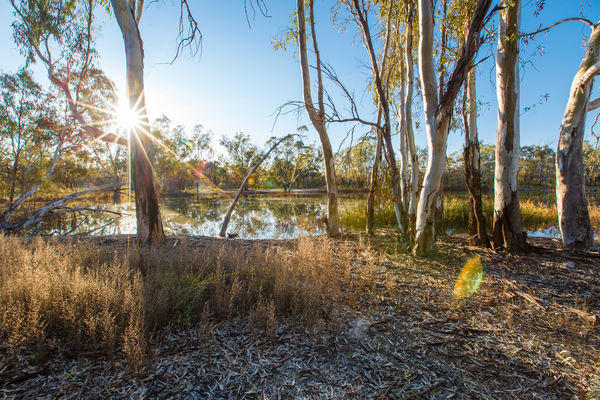The Mallee Aboriginal Reference Group (ARG) visited Hattah-Kulkyne National Park to see firsthand how water for the environment projects have improved the landscape – in particular, the health of the Hattah Lakes and floodplain.
Just over 100 years ago, the River Murray was changed forever. Instead of water flowing across the landscape naturally, it was captured in storages by dams and weirs, diverted by pipelines, levees and constructed channels, and used for towns, industry and farming. As a result, big floods became less frequent, and the health of the river and the wetlands, floodplains and lakes that relied on the river suffered. Environmental watering projects are helping mimic more traditional water flows, bringing new life and hope to unique sites in the Mallee, such as Hattah Lakes.
The focus of this on-Country day was to demonstrate the difference between areas receiving environmental water, compared to those which aren’t. Thanks to a series of pumps and weirs installed in 2012 as part of the first stage of the Hattah project, large areas of the Hattah-Kulkyne National Park are receiving water, and the group spent the day exploring these lakes, which are brimming with wildlife and fresh growth, before moving on to visit a dry area.
Everyone was stunned by the difference. The ARG members described the un-watered areas as being like a ‘fire and brimstone landscape’.
“We ended up on the banks of a dry lake in the far north of the national park, and here we really saw what happens to our land when it’s not cared for; all the water plants are gone, replaced with salt bush and other dryland plants. The banks are lined with trees only just clinging to life. There are no birds and a light salt crust has formed on the bottom of the lake.”
The group participated in a plant survey and were delighted to see that native plants are returning to areas getting water, including ‘old man weed’ and ‘broom brush’. ARG members were able to share the importance of these plants, once used for medicinal purposes and to keep their elders’ camps clean.
The experience and knowledge-sharing between the ARG and Mallee CMA staff will be invaluable for future water for the environment projects, as the ARG provides guidance to the CMA on Aboriginal community engagement and input into Mallee CMA initiatives and regional plans.

Hattah Lakes, by Mallee CMA